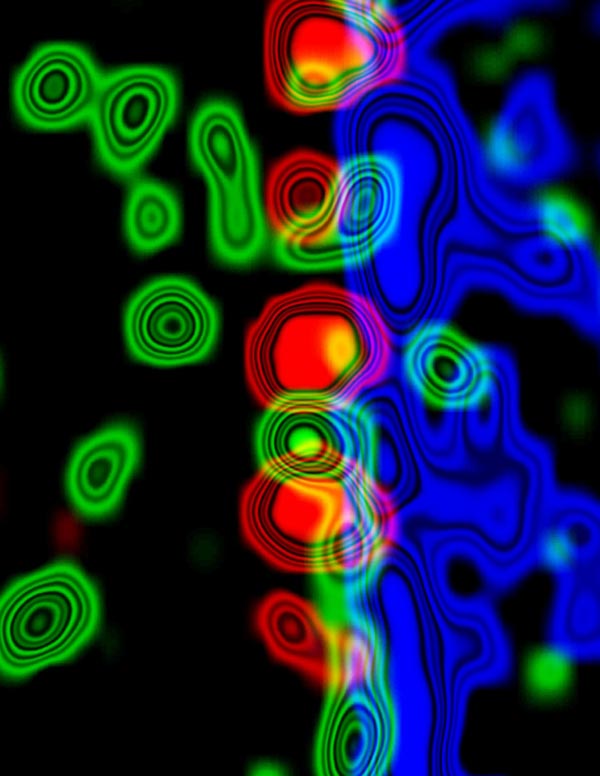

Scientists discovered that nuclear pores in astrocytes may play important roles in the brain.
Courtesy of Akassoglou lab, Gladstone Institute
Every brain cell has a nucleus, or a central command station. Scientists have shown that the passage of molecules through the nucleus of a star-shaped brain cell, called an astrocyte, may play a critical role in health and disease. The study, published in the journal Nature Neuroscience, was partially funded by the National Institutes of Health (NIH).
“Unexpectedly we may have discovered a hidden pathway to understanding how astrocytes respond to injury and control brain processes. The pathway may be common to many brain diseases and we're just starting to follow it,” said Katerina Akassoglou, Ph.D., a senior investigator at the Gladstone Institute for Neurological Disease, a professor of neurology at the University of California, San Francisco, and a senior author of the study.
Some neurological disorders are associated with higher than normal brain levels of the growth factor TGF-beta, including Alzheimer's disease and brain injury. Previous studies found that after brain injury, astrocytes produce greater amounts of p75 neurotrophin receptor (p75NTR), a protein that helps cells detect growth factors. The cells also react to TGF-beta by changing their shapes and secreting proteins that alter neuronal activity.
Dr. Akassoglou's lab showed that eliminating the p75NTR gene prevented hydrocephalus in mice genetically engineered to have astrocytes that produce higher levels of TGF-beta. Hydrocephalus is a disorder that fills the brain with excess cerebral spinal fluid. Eliminating the p75NTR gene also prevented astrocytes in the brains of the mice from forming scars after injuries and restored gamma oscillations, which are patterns of neuronal activity associated with learning and memory.
The cell nucleus is a ball of chromosomes wrapped in a protective fatty membrane. In this study, the researchers discovered that treating astrocytes with TGF-beta freed a small piece of the p75NTR protein to bind to nucleoporins, a group of proteins that regulates the passage of molecules in and out of the nucleus. Their results suggest that binding enhances the flow of certain critical molecules into the nucleus and enables astrocytes to enter a reactive state.
“This research highlights the importance of the nuclear pore complex in the brain and raises the possibility that it may be a target for treating a wide range of neurological disorders,” said Jill Morris, Ph.D., program director at the NIH's National Institute of Neurological Disorders and Stroke (NINDS).
The scientists used high-resolution microscopes to watch the astrocyte nucleus in action. Nuclear pores that did not have the p75NTR gene were slightly larger than normal. When the scientists treated astrocytes with TGF-beta, they saw p75NTR proteins bind to nucleoporins and open the pores. This allowed transport into the nucleus of a protein called Smad2, which is essential for TGF-beta to exert its effects on astrocytes. In other experiments, the scientists showed that eliminating p75NTR from astrocytes blocked the transport of Smad2 into the nucleus.
“Nuclear pores are gatekeepers and p75NTR appears to be the key to unlocking particular gates,” said Dr. Akassoglou. “We discovered novel roles for both players and will continue to study how the nuclear pore complex controls neuronal development and disease.”
###
This work was supported by grants from NIH (NS051470, NS052189, NS066361, NS082976, AG047313, GM103412, RR004050), European Commission (FP7 PIRG08-GA-2010-276989), German Research Foundation (SCHA 1442/3-2), US National Multiple Sclerosis Society, American Heart Association, German Academic Exchange Service.
References:
Schachtrup et al. “Nuclear pore complex remodeling by p75NTR cleavage controls TGF-β signaling and astrocyte functions,” Nature Neuroscience, June 29, 2015. DOI: 10.1038/nn.4054
For more information, visit: http://www.
NINDS is the nation's leading funder of research on the brain and nervous system. The mission of NINDS is to seek fundamental knowledge about the brain and nervous system and to use that knowledge to reduce the burden of neurological disease.
About the National Institute on Aging: The NIA leads the federal government effort conducting and supporting research on aging and the health and well-being of older people. It provides information on age-related cognitive change and neurodegenerative disease specifically at its Alzheimer's Disease Education and Referral (ADEAR) Center at http://www.
The National Institute of General Medical Sciences (NIGMS) supports basic research that increases understanding of biological processes and lays the foundation for advances in disease diagnosis, treatment and prevention. NIGMS-funded scientists investigate how living systems work at a range of levels, from molecules and cells to tissues, whole organisms and populations. The Institute also supports research in certain clinical areas, primarily those that affect multiple organ systems. To assure the vitality and continued productivity of the research enterprise, NIGMS provides leadership in training the next generation of scientists, in enhancing the diversity of the scientific workforce, and in developing research capacities throughout the country. More information about NIGMS can be found at http://www.
About the National Institutes of Health (NIH): NIH, the nation's medical research agency, includes 27 Institutes and Centers and is a component of the U.S. Department of Health and Human Services. NIH is the primary federal agency conducting and supporting basic, clinical, and translational medical research, and is investigating the causes, treatments, and cures for both common and rare diseases. For more information about NIH and its programs, visit http://www.












